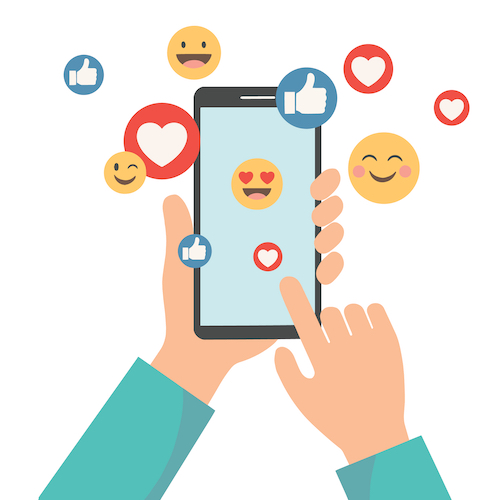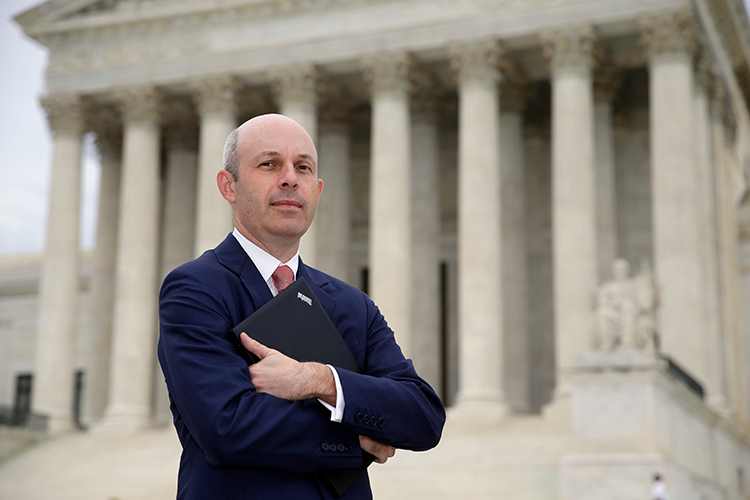Moons, Fire and Pigs: Emojis can be confusing in court

The more emojis and emoticons are used in communications, the more they appear in courtroom litigation, says Eric Goldman, associate dean of research and co-director of Santa Clara University School of Law’s High Tech Law Institute. (Image from Shutterstock)
Sometimes an eggplant is just an eggplant, but in the emoji world, it’s usually not. But is sending someone an eggplant emoji or a winky face proof of sexual harassment? When does a gun emoji mean someone is threatening another person with death? Does a thumbs-up emoji mean acceptance of a contract?
These are all questions presented in courtrooms across the country and the world. As almost everyone now knows, emojis are images, symbols or icons used in text messages, emails and communications on social media platforms.
The more emojis and emoticons are used in communications, the more they appear in courtroom litigation, says Eric Goldman, associate dean of research and co-director of Santa Clara University School of Law’s High Tech Law Institute. In 2004, there was at least one court case from the Eastern District of Virginia discussing the use of the smiley face. By 2016, there were at least 26 cases in which emojis and emoticons were referenced in court opinions, and by 2023, there were more than 200, says Goldman, who keeps track of judicial opinions relating to emojis and emoticons.
The 2023 cases reference a host of emojis and emoticons, including heart eyes, pig, skull and the devil.
“What started as a trickle of cases has become a flood,” Goldman says. “Lawyers need to understand that while emojis are being used, they don’t always mean the same thing to everyone.”
Casual conversation across texts or on platforms like Snapchat can sometimes involve a series of emoji exchanges without a single written word ever being used. For example, two individuals could exchange a string of emojis—such an airplane, roses, a cherry and a crown—that would raise questions as to whether they were discussing human trafficking of a minor, according to Goldman.
“Context is everything when it comes to emojis,” says Patrick A. Wright, a family law litigator in Lewisville, Texas, and a member of the ABA Techshow 2025 planning board. Interpretation of a particular emoji is contingent on what the sender and receiver believe the wordless communication represents, he adds.
One of the more recent battles over the interpretation of an emoji on Twitter involves former Bed Bath & Beyond investor Ryan Cohen, who in 2022 posted a tweet responding to a CNBC story predicting that the company’s share price would drop. Cohen reposted the CNBC story with a photo of a woman shopping, along with the comment “At least her cart is full” and an emoji of a smiling moon. Other investors said they interpreted his use of the smiley moon emoji as a signal that he believed Bed Bath & Beyond stock was going up “to the moon” and that people should buy or hold, according to court documents.
In 2023, U.S. District Judge Trevor McFadden, who sits in the District of Columbia, found that Cohen and his venture capital firm had to face plaintiffs’ fraud claims, including their allegation that the smiley moon emoji was a fraudulent misrepresentation. McFadden described the tweet with the emoji as “plausibly misleading.”
In a separate case decided in June, U.S. District Court for the Southern District of New York Judge Dale Ho said two former Bed Bath & Beyond shareholders could not force Cohen to return profits from selling his stake. Ho found that the shareholders’ claims were moot due to the company’s bankruptcy filing, according to court documents.
It is incumbent on lawyers, particularly litigators, to stay up to date on emoji use and consider how to properly introduce them as evidence if critical to a case, says Wright, managing partner of the Wright Firm.
There are some resources. The Unicode Consortium maintains an emoji list. In addition, Emojipedia provides information about the generally accepted interpretations and slang meanings. But these resources alone won’t provide enough context if the meaning of an emoji is at play in litigation or a criminal or domestic proceeding, Wright says.
 Emoji interpretation can be generational, according to Leslie Y. Garfield Tenzer, a professor at the Elisabeth Haub School of Law at Pace University.
Emoji interpretation can be generational, according to Leslie Y. Garfield Tenzer, a professor at the Elisabeth Haub School of Law at Pace University.
One problem is that emoji interpretation can be generational, according to Leslie Y. Garfield Tenzer, a professor at the Elisabeth Haub School of Law at Pace University. She co-authored a Legal Emoji Dictionary, which is posted online by her university.
“An older person looks at an eggplant and sees a vegetable, but someone younger sees a penis,” Tenzer says. “It really becomes an issue if in a case the decision-maker is an older jury or an older judge. They may interpret the meaning differently from the individual who used it in their conversation.”
In addition, there are no guidelines for judges in how to handle emojis outside of regular rules of evidence, according to Goldman. Sometimes a judge might determine an emoji is a question of fact for the jurors; sometimes it’s a question of law for the judge to decide on. And in some cases, judges have chosen to exclude emojis from evidence altogether, he adds.
Brian L. Rubin, a former U.S. Securities and Exchange Commission enforcement lawyer, warns that emojis can easily lead to misinterpretation in the professional environment. He advises lawyers and clients to steer clear of using them to avoid miscommunication and, potentially, a legal dispute, including an SEC enforcement action.
For example, a common emoji like fire could mean a positive reaction or it could be negative, like “You just burned me,” says Rubin, co-head of the securities enforcement practice at Eversheds Sutherland and a partner in the firm’s Washington, D.C. office. “It’s ambiguous without context.”
Lawyers should be prepared to utilize an outside expert to clarify the meaning of an emoji if it is at issue, Goldman says. In criminal cases, for example, that might mean bringing in a law enforcement officer who is an expert on gang communications.
Desmond Upton Patton, the Brian and Randi Schwartz University Professor of Social Policy and Communications and a Penn Integrates Knowledge Professor at the University of Pennsylvania, warns that particularly in cases involving the criminal justice system, the use of emojis can be hyper localized. He says some cases, such as those involving potential gang activity or sex trafficking, might require an expert who understands the particular community to which the sender and receiver belong.
“The running man emoji with the smiling devil emoji and the gun emoji may mean that someone is coming to get you on the South Side of Chicago but something completely different in North Carolina,” Patton says.



